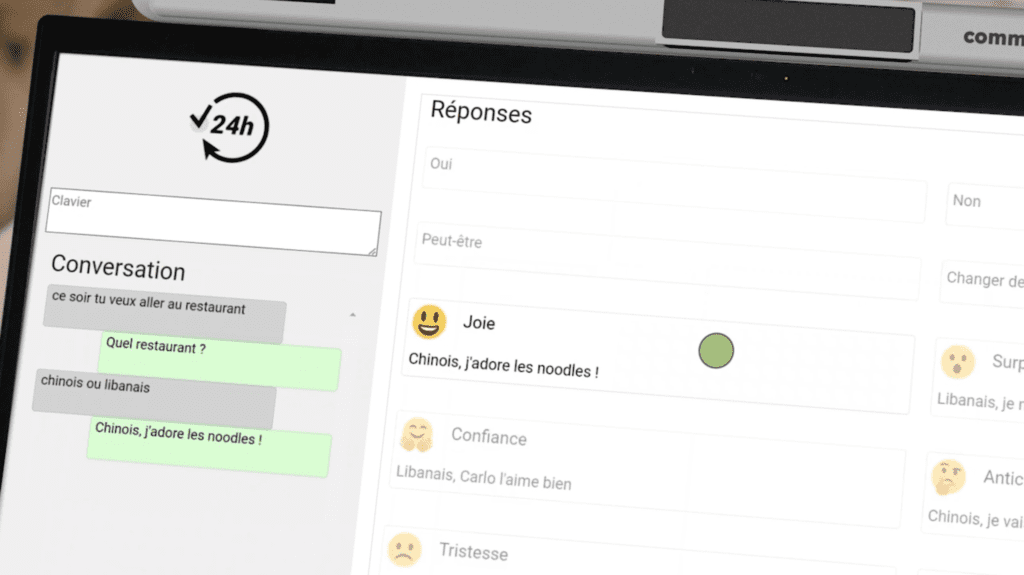

An eye-controlled, free communication software, based on artificial intelligence, to give a voice back to people suffering from neurodegenerative diseases.


OUR PROJECT
IGOOR is a free, open-source, eye-controlled conversational application designed to provide people suffering from neurodegenerative diseases or paralysis with a fluid, natural means of communication.
You can speed up its development by taking part in the crowdfunding campaign:
PROJECT DESCRIPTION
IGOOR offers sentence predictions, adapts to individual communication styles and learns from user data to improve accuracy over time.
- Navigation via eye-tracker: the software’s intuitive interface can be easily navigated using eye control,
- Voice synthesis with cloned user’s voice, allowing the user to speak with their voice reconstructed by the AI, improving the emotional connection for themselves and others,
- Possibility of answering any question asked by the speaker (via the device’s microphone), through a mix of default answers, answers generated by the AI according to the wheel of emotions (“joy”, “sadness”, etc.), and previously used answers,
- Increased accuracy of the AI’s predictions thanks to a text about the person suffering from the pathology, describing their biography, family, relationships, the current state of their illness, etc. This text is used to refine the AI’s predictions, and can be updated according to the progress of the disease, new developments, etc,
- Primary needs interface with editable needs (needs, preferences, labels),
- Multilingual (supported languages in the first version: French, English),
- Predictive keyboard: the keyboard suggests whole sentences based on the first letters (instead of just words).
OBJECTIVES
Priority objectives
- Increase the speed of dialogue between the user and those around him,
- Increase the accuracy of predictions based on a textual biographical document,
- Better balance between speed, freedom and accuracy of expression,
- Speech synthesis incorporating the user’s voice, reconstructed by AI from an audio corpus supplied by the user,
- Simplicity and ergonomics of the user interface.
Secondary objectives
- Increase the fidelity of the user’s style by training on a corpus of texts, images, music, videos, etc. provided by the user,
- Integrate all environmental information to improve the intelligence of responses (GPS position, object detection, weather, user’s local schedule, scenes, people and situations through the camera and multimodal AI),
- Ensuring continuous training on the responses provided when using the device, to constantly improve the relevance of the predicted responses.
OUR VALUES
A FREE software
This software is free and open source, meaning it will be available online for free, along with its source code, for everyone, regardless of their income. Everyone should be able to benefit from an efficient communication aid solution.
Access to the source code encourages collaboration among developers, users, and experts to continuously improve the software.
We have chosen to distribute the software under the GPLv3 license to ensure that everyone is equally free to use IGOOR as is, or to modify it to create their own version with features specific to their needs.
If someone improves the existing code, they will be required to publish the source code in turn. This ensures that in the future, IGOOR remains free and propagates its freedoms even in other forms.
Initially distributed for Windows, it is designed to be cross-platform and ported to other operating systems (Linux and Mac).
Hardware agnostic
The tool will be designed to operate independently of any specific hardware, be it a microphone, a camera, an eye control system, or any other input/output peripheral. Adopting a hardware-independent approach is a fundamental pillar in the development of assistive communication tools that are truly inclusive and accessible to all. By promoting flexibility, affordability and freedom of choice for users, we are helping to create a more inclusive digital society that respects the diversity of needs.
Offline functionality
We are orienting the development towards a usage that requires minimal Internet connection, which is particularly important for people with disabilities, especially when they are in areas with limited connectivity.
Some software features will always require an Internet connection, such as weather awareness. However, these features are not essential.
Additionally, certain hardware limitations currently prevent us from providing a completely offline solution. For example, it is technically impossible today to offer IGOOR’s prediction speed without using an external cloud AI provider.
We are confident that these hardware limitations will be overcome very quickly, and we are committed to updating our code as soon as possible so that the entire software can operate without the need for external connectivity.
GET INVOLVED
Your contribution is crucial to improve the quality of life for patients with ALS and other conditions affecting communication.
With your donation, hundreds of thousands of patients will be able to better communicate with their loved ones and express their physiological, social, and emotional needs.
You can also get involved in other ways :